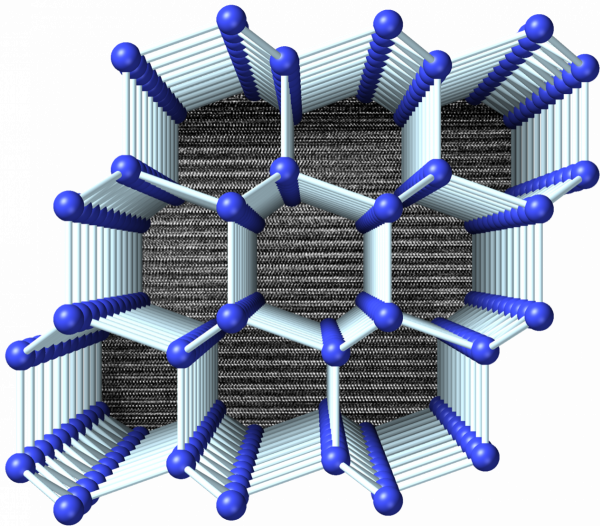Jun 7 2021
A research team, headed by Thomas Shiell and Timothy Strobel from the Carnegie Institution for Science, has devised a new technique for producing an innovative crystalline form of silicon with a hexagonal structure.
 Visualization of the structure of 4H-Si viewed perpendicular to the hexagonal axis. A transmission electron micrograph showing the stacking sequence is displayed in the background. Image Credit: Thomas Shiell and Timothy Strobel.
Visualization of the structure of 4H-Si viewed perpendicular to the hexagonal axis. A transmission electron micrograph showing the stacking sequence is displayed in the background. Image Credit: Thomas Shiell and Timothy Strobel.
This novel silicon could be used for fabricating advanced electronic and energy devices with improved properties that surpass those of the "normal" cubic form of silicon used at present. The study was published in the Physical Review Letters journal.
Silicon has a major role in human life and is the second most abundant element in the Earth's crust. When silicon is combined with other elements, it becomes essential for several infrastructure and construction projects.
Silicon in its pure elemental form is significant enough that that the longstanding technological center of the United States—California’s Silicon Valley—was nicknamed in honor of it.
Similar to all elements, silicon can take different crystalline forms, known as allotropes, in the same manner that super-hard diamond and soft graphite are both forms of carbon. But the type of silicon that is often used in electronic devices, such as solar panels and computers, has the same kind of structure as diamond.
In spite of its ubiquity, this type of silicon is not actually completely improved for advanced applications, such as high-performance transistors and certain photovoltaic devices.
Although different types of silicon allotropes with improved physical properties are hypothetically viable, only a few exist in practice. This is due to the lack of familiar synthetic pathways that are presently accessible.
A revolutionary new form of silicon, known as Si24, was previously developed by Strobel’s laboratory. This silicon has an open framework made up of a series of 1D channels.
In the new study, Shiell and Strobel headed a research team that utilized Si24 as the beginning point in a multi-stage synthesis pathway that led to a highly oriented crystal in a form known as 4H-silicon, dubbed for its four repeating layers in a hexagonal structure.
Interest in hexagonal silicon dates back to 1960, because of the possibility of tunable electronic properties, which could enhance performance beyond the cubic form.
Timothy Strobel, Carnegie Institution for Science
Hexagonal forms of silicon have been formerly synthesized but only by depositing thin films or as nanocrystals that coexist with random materials. The recently demonstrated Si24 pathway creates the first high-quality, bulk crystals that act as the basis for upcoming research activities.
The team was able to interpret the transition mechanism from Si24 to 4h-Si and the structural link that helps preserve highly oriented product crystals.
This was done by using the sophisticated computing tool known as PALLAS, which was earlier developed by members of the research team to estimate the structural transition pathways, such as how water becomes ice when frozen steam when heated.
In addition to expanding our fundamental control over the synthesis of novel structures, the discovery of bulk 4h-silicon crystals opens the door to exciting future research prospects for tuning the optical and electronic properties through strain engineering and elemental substitution.
Timothy Strobel, Carnegie Institution for Science
“We could potentially use this method to create seed crystals to grow large volumes of the 4H structure with properties that potentially exceed those of diamond silicon," Shiell concluded.
Carnegie's Li Zhu was also a member of the research group, along with Brenton Cook and Dougal McCulloch from RMIT University and Jodie Bradby from The Australian National University.
The study was funded by the National Science Foundation, Division of Materials Research.
Part of this study was conducted at HPCAT (Sector 16), Advanced Photon Source (APS), Argonne National Laboratory.
The operations at HPCAT were supported by DOE-NNSA’s Office of Experimental Sciences. The Advanced Photon Source is a U. S. Department of Energy (DOE) Office of Science User Facility operated for the DOE Office of Science by Argonne National Laboratory.
Journal Reference:
Shiell, T. B., et al. (2021) Bulk Crystalline 4H-Silicon through a Metastable Allotropic Transition. Physical Review Letters. doi.org/10.1103/PhysRevLett.126.215701.
Source: https://carnegiescience.edu/